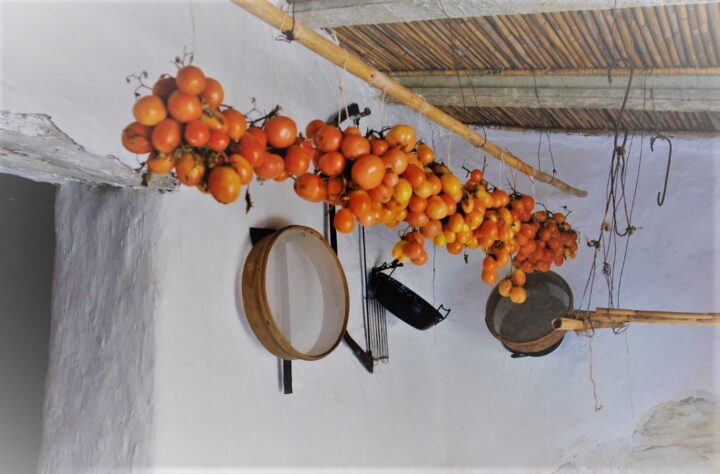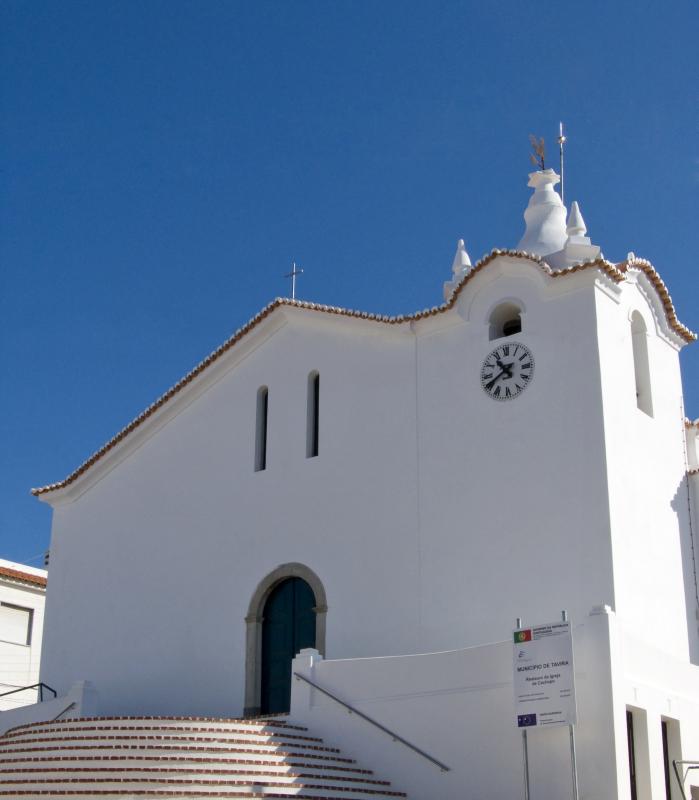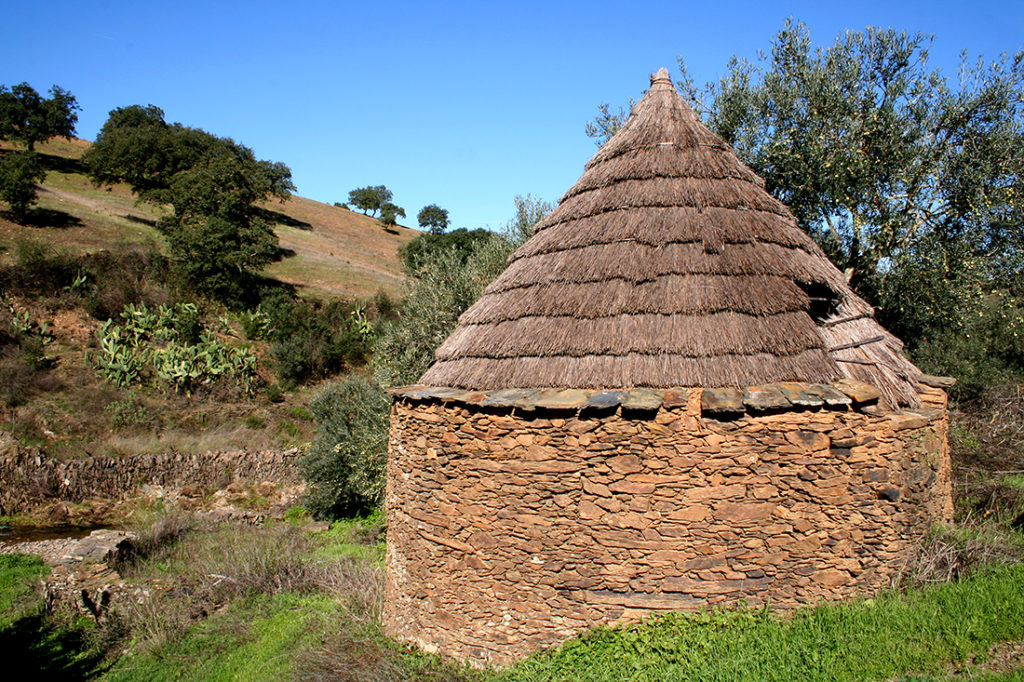Tours, workshops, culinary demonstrations and conversations complete the program of “Os Dias Abertos de Cachopo”, which will take place in this village in the mountainous interior of the municipality of Tavira from March until June.
The start of the initiative takes place on the 18th and 19th of this month. Thus, on the 18th of March, in Monte do Graínho, the tour and workshop “Agricultural Biodiversity – heritage and landscapes” takes place with Associação Colher para Semear – Portuguese Network of Traditional Varieties.
On the 19th, Monte da Mealha hosts a culinary demonstration “Agricultural Biodiversity – ancient foods and innovation”, by Chef Margarida Vargues, as well as a conversation promoted by the Associação Colher para Semear.
The motto of the meeting is the “winter tomato” also known as “hanging tomato” or “guard tomato”. Like other foods, tomatoes, after picking, are stored and preserved to last until the next harvest. The cold in the mountains, in winter, removes its color and accentuates its flavor.
Margarida Vargues will show the culinary possibilities of this type of tomato and other seasonal products – how to cook with the family and children and how these products are prepared in other areas of Mediterranean culture.
The free activities will have a maximum duration of seven hours, with departure from Tavira scheduled for 09:30 am. The actions have a limited number of people and transport is the responsibility of the municipality.
All those interested must register, until the 15th of March, by clicking here (“Agricultural Biodiversity – heritage and landscapes”) or here (“Agricultural Biodiversity – ancient foods and innovation”).
“The Open Days of Cachopo” address topics such as biodiversity, landscape, geodiversity, religious artistic heritage, the history of cereal production, food and gastronomy, vernacular architecture and the use of construction materials, enabling research to citizen participation, as well as knowledge sharing by the community.
The work, coordinated by the Municipal Museum of Tavira, aims to protect and safeguard the cultural and natural heritage (one of the goals of the Sustainable Development Goal “Resilient Cities and Communities” of the 2030 Agenda for Sustainable Development). This includes the relationship between intangible heritage and sustainability, centered on the Mediterranean Diet and thus valuing territorial resources and knowledge.
This program is part of the project “Mediterranean Diet in Low Density Territories”, financed by the European Regional Development Fund under the Operational Program CRESC Algarve 2020.
Those interested in exploring Cachopo, during the weekend, have at their disposal, for accommodation, the Discovery Centers of the Rural World, located in the hills of Feiteira, Casas Baixas and Mealha. Can book by clicking here.

The program of “The Open Days of Cachopo” continues on the 15th of April, with the tour “Cereal production in Cachopo: biodiversity and milling systems” by the Colher para Semear Association – Portuguese Network of Traditional Varieties, which will be guided by Carlos Faísca (historian) and Custódio Campos (miller).
At the beginning of the XNUMXth century, with the rediscovery of the fundamentals of genetic transmission (Mendel's Laws), there was an increased effort to obtain agricultural plants with certain characteristics. Cereals, the basis of human nutrition until very recently, have become more productive, but in many cases, requiring significant investment in various production factors.
«In this context, the geography of dissemination of seeds of improved cereals and/or hybrids was very uneven. There were regions which, due to their economic, social and agrarian structure, continued, until the second half of the XNUMXth century, the use of varieties adapted over millennia by farmers to the local agro-ecological conditions. Cachopo seems to have been one of those cases, where we will find the living memory of the cultivation of barbelo rye and [wheat], among other cereals», explain the organizers.
The next day, April 16th, there will be a cooking demonstration and a conversation on “Agricultural Biodiversity – ancient foods and innovation” by Margarida Vargues, Chef de cuisine, and by the Associação Colher para Semear – Rede Portuguesa de Variedades Tradicionais
The activity will focus on the cereal heritage of Cachopo, on the flavors and knowledge of cereals and seasonal products – how to cook with the family and with children and how these products are prepared in other areas of Mediterranean culture.
In April, activities are part of the celebrations of the National Day of Windmills and the International Day of Monuments and Sites.

In May, for the 13th, the tour “The parish of Santo Estêvão de Cachopo: memory and identity” is scheduled, which will be guided by Marco Sousa Santos (art historian) and Albino Martins (deacon).
Founded in the 1st half of the XNUMXth century, the church of Santo Estêvão de Cachopo keeps the memories of almost five centuries of history of this parish and its people. Meeting space, stage for ceremonies, headquarters for confraternities and the starting and ending point for processions, this building has always been the religious and social center of the surrounding territory.
Despite the works that profoundly altered the aesthetics of the building, the architecture still recognizable traces of its antiquity. Inside, cult implements and images (some from the XNUMXth century) show the number and type of devotions that have settled in the parish, contributing to a better understanding of its history and the beliefs and traditions cherished by its population.
On Sunday, May 14th, another pedestrian walk will take place, this time on “The paths of the Serra between Montes de Cachopo for the interpretation of architecture and landscape”, guided by Miguel Reimão Costa (architect).
The landscape of Cachopo is characterized, like other sub-units of the Serra, by the presence of lots of harvesters, caretakers and farmers, with particular aspects in terms of the construction and organization of the traditional house.
A large part of the parish's fields of harvesters are concentrated in its central part, corresponding to the old Cachopo estate, left as common land to the local populations. Starting from these lands, the route will seek to interpret the ways of living in the region, revealing some of the themes that mark the diversity of its architecture.
In May, the activities are part of the celebrations of the International Museum Day. Simultaneously, the Cachopo Fair takes place in the village.
Finally, on June 3, the tour “Hidden stories in the rocks and landscapes of Cachopo” will take place, with Francisco Lopes and Hélder Pereira (biology and geology teachers, specialists in geological heritage and geoconservation) as guides.
More than just a walk… we propose an authentic journey through time to explore the stories hidden in the rocks and landscapes of Cachopo and surroundings. The plot of these stories includes a journey of 350 million years, with underwater avalanches, fossils of marine organisms and even missing mountain ranges and oceans.
On the following day, June 4th, the architect Alexandre Miguel Costa will guide the tour dedicated to the theme “Processes and technicians of traditional, vernacular construction of shale masonry”.
This is a walk around the surroundings close to the village of Cachopo, visiting some of the works by the now extinct GTAA Sotavento (Support Office for Aldeias do Algarve – Sotavento). Approaches to the recovery and rehabilitation of buildings, lanes and paths will be explained, focused on the (re)use of traditional, vernacular construction techniques and processes, which today have practically disappeared.



















Comments